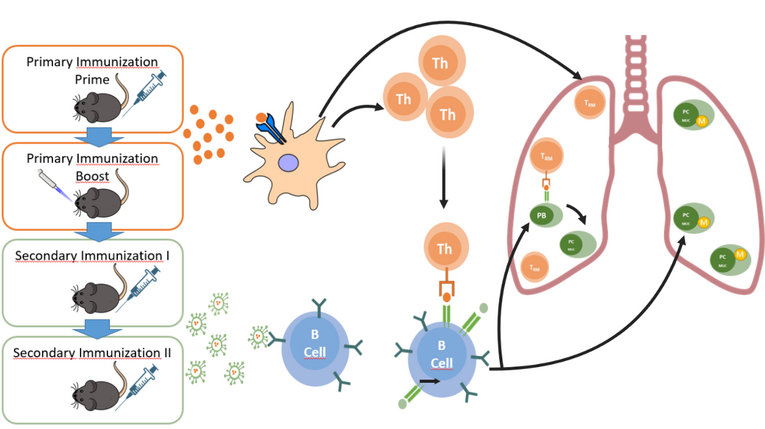Inducing mucosal antibody responses against HIV-1 by intrastructural help (ISH) using virus-like particle (VLP) vaccine
A vaccine which induces a mucosal immune response may be key to fast and efficient control of viral replication at the mucosal entry site. However, the development of vaccines that induce long-lasting protective antibody levels at mucosal entry site remains challenging. Some vaccines induce life-long immune responses. Our research group aims to take advantage of these pre-existing T helper cells to amplify the HIV Env B cell response. To do so, experimental VLP vaccines that display HIV Env on the surface and have a T cell epitope of a licensed vaccine encapsulated are being used as a secondary immunization strategy. Env-specific B cells are capable to uptake whole VLPs and present the internal antigens of the VLP on its MHC-II molecules. Thus pre-existing T helper cells can be used to elaborate the Env-specific antibody response. Besides, it was revealed that a systemic prime immunization followed by a nasal boost provided robust systemic and mucosal protection against SARS-CoV-2.
In this proof-of-concept study, the respiratory tract is chosen as the mucosal tissue because of its accessibility to immunization. Moreover, HIV Env protein is used as a model antigen because of the established methods. In this project, we will use a primary immunization regimen, containing of a systemic mRNA prime and a nasal adenoviral vector boost immunization against SARS-CoV-2 followed by a secondary immunization regimen with HIV VLPs. The VLPs presents the HIV Env protein on its surface and have a SARS-CoV-2 spike-specific T helper cell epitopes enclosed. With this immunization strategy, we aim to investigate if SARS-CoV-2 spike-specific T helper cells can be harnessed by ISH to direct Env-specific B cell responses to mucosal sites by either nodular T follicular helper cells, which instruct Env-specific B cell and plasmablasts (PB) in the lymph nodes to home to mucosal tissue via chemokines, or whether circulating PBs encounter pre-existing tissue-resistant T helper cells (hTRMs) at the mucosal site to receive differentiation signals into mucosal resident plasma cells (PC) (Figure 1).
In order to proof these hypotheses, we will:
Aim 1) confirm that a SARS-CoV-2 mRNA immunization induces T helper cell responses providing ISH to VLPs.
Aim 2) compare spike-specific mucosal B cell responses after i.n. boost.
Aim 3) compare Env-specific mucosal B cell response after the secondary immunization regimen.
Aim 4) characterize the transcriptome of Env-specific plasma cells in the lung.




